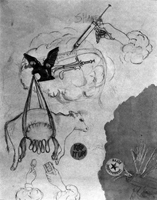CLAIRE PENTECOST: ‘Interior Studies’
By HOLLAND COTTER
Higher Pictures
764 Madison Avenue, near 66th Street
Through Dec. 11
Claire Pentecost is best known as an artist-activist working with, among other collectives, Critical Art Ensemble, which has done research in biotechnology, specifically into the use of genetically modified organisms in food. At Higher Pictures, however, she is showing a striking series of pictures that in some cases don’t look overtly political, and that both are and aren’t conventional photographs.
As Ms. Pentecost explains in a gallery news release, several years ago, in a beat-up studio space in Chicago, where she lives, she started drawing directly on the walls. Her routine was to photograph a wall drawing, work on it some more, photograph it again, apply collage elements to the surface and photograph it yet again. Each photograph became a finished work, which she produced as a palladium print, a type of print that, with its matte surface, could be mistaken for a drawing.
The photographed drawings mix written words, plant and animals forms, human figures and body parts, with contents changing slightly from version to version. A picture called Einstein’s Brain 12 Times shows a dozen little images of a brain lined up in grid formation on a plain ground. In a related photograph, the same brains are transformed into a flower with the addition of petals and leaves pinned onto the drawing. In a third photograph three days later, the petals have dried up and the leaves wilted, and the brains are visible again.
In general, a play of organic and artificial runs through the show. In Bessie, a cow with grotesquely swollen udders is airlifted by an American eagle (possibly a plastic figure collaged onto the original drawing), as hands holding syringes reach from the sky. In Conjuring, a syringe has hit a cow and turned its front quarters into the figures of a copulating but headless human couple.
Everything in the floating world of this art is in the process of change and under threat. Women have multiple breasts; humans and apes alike have tails; the maligned faces of politicians ” Bill Clinton, George W. Bush ” float up like ghosts from a compost heap.
To go through the show, picture by picture, is like examining the walls of Ms. Pentecost’s old studio transposed to a gallery space, or seeing the interior of a mind thinking or dreaming inventively. In the exhibition’s final picture we reach the door of what we can assume is her studio in an image of a deadbolt lock to which is attached a newspaper clipping about the human genome.
Ms. Pentecost’s images, it turns out, are saturated in politics. They are documents of an artist-activist passionately at work in two interlocked mediums, and, most important, in privacy, a potent combination.
More information available at: http://www.nytimes.com/2010/12/03/arts/design/03galleries-CLAIREPENTEC_RVW.html

